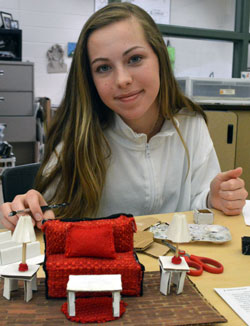Addison Rhoton, Chelsea Wierenga and Gia Ross blended blue and black bedazzled and metallic art to create a 6-by-10-inch teenager’s dream garage, complete with shelving, cabinets, French doors, furniture and even room for a 3-D printed car.
“I like architecture and that’s a type of art, as you can see here,” Addison said, explaining her interest in creating digital floor plans and building a space from there.
In art teacher Janine Campbell’s classroom, West Middle School seventh- and eighth-graders were busy bringing their own miniature spaces to life, step-by-step, from designing blueprints on Floorplanner.com to embellishing the rooms with little fans, pictures and even a mini lawn mower.

The results were small-scale “Artist Interiors” – like sophisticated little dollhouses — showcasing unique and eccentric flair. Intricate décor, colorful wallpaper and itsy-bitsy furniture complemented the design elements and principles of professional artists featured in Scholastic Art magazine.
Inspired by Artists
Campbell and STEM teacher Jamie Dennett tasked students to choose a professional artist featured in the magazine and create a room designed with that person in mind, considering style and aesthetics. They then chose an imaginary client who would live in the space: city-dwelling young professionals, future moon colonists, teenage girls who love sparkly things. For example, Addison, Chelsea and Gia modeled their style after the work of an artist named Nozami, and imagined a 16-year-old girl client named Piper.
“Whatever the design choices they are making have to fit in with their artist… it’s all a nod to things they notice the artist does in their work,” Campbell said.

Eighth-graders Zach Bush, Brady Ahearne and Collin Ford designed their gaming room space using principles of the artist Mickalene Thomas, who they describe as having a comic- book style. They said they used bright colors to make elements “pop” with energy. They said they learned about the effects of color on mood, from adding elegance to creating a soothing atmosphere.
They also learned about scale. “It was a little hard to dial things down to size,” Brady said. “We had to think things through in making them small.”
Campbell said the project goes deeper than meets the eye. Students used design thinking, which involves empathizing with others to take into account their unique needs and interests when creating a product. The process is used in many creative careers, Campbell said, and gets students thinking about applying their learning when they enter the workforce.

“With middle schoolers’ social and emotional development, the idea of empathy and getting to see something through someone else’s lens is important, and if we can do that through design this is a great opportunity,” she said.
The rooms will be displayed in the school’s media center until the end of the school year.
Campbell often challenges her students to embrace out-of-the-box design.
Her students also recently created wearable art including necklaces, earrings and other pieces using TinkerCad and Morphi 3D printing and applications on a 3D printer. Students Joshua Hager, Chelsea Wierenga Chase Miller and Allison VanderSloot won regional Scholastic Art Awards for their design and the project was featured in SchoolArts Collection Magazine.
CONNECT
Thinking by design, solving problems and having fun
Teachers team up to design think their way to cross-curriculum project

















